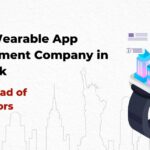
The fashion industry is characterized by its dynamic nature and constant evolution, with trends changing swiftly and brands working diligently to maintain their relevance. A fundamental component of a fashion brand’s identity is its logo—an icon that embodies the brand’s essence, values, and distinctiveness. Throughout the years, bespoke logo design has been instrumental in the success and transformation of fashion brands, enabling them to create a robust visual identity within a competitive landscape. This blog will examine the progression of custom logo design in the fashion sector, its influence on brand recognition, and its ongoing role in shaping consumer perceptions.
The Importance of Custom Logo Design in Fashion
In the fashion sector, a logo transcends mere symbolism; it embodies the essence and aesthetic of a brand. From the striking, recognizable swoosh of Nike to the sophisticated interlocking Cs of Chanel, a custom logo design forges an instant bond with consumers. An effectively crafted logo conveys a brand’s quality, innovation, and the commitments it makes to its clientele.
The significance of custom logo design within the fashion industry is paramount. Logos enable brands to differentiate themselves in a crowded marketplace, providing a distinctive identity that consumers can easily identify and recall. Furthermore, given that fashion is inherently visual and emotive, logos play an essential role in narrative development, brand positioning, and fostering consumer engagement.
Early Days: Simplicity and Elegance in Logo Design
In the early 20th century, fashion brands predominantly embraced logo designs characterized by simplicity and elegance, prioritizing legibility and timeless aesthetics. These logos typically featured the brand’s name rendered in a distinctive yet understated typeface, often devoid of elaborate graphical elements. A notable instance is Coco Chanel’s logo, created in 1925, which has remained largely unchanged over the years.
The interlocking C’s have become emblematic of luxury, sophistication, and enduring elegance. During this period, logos served primarily as a means of brand identification rather than as bold visual statements. The emphasis was placed on simplicity, elegance, and a subtle branding approach that allowed the product to take center stage. This minimalistic philosophy prevailed in the fashion industry for several decades.
Logos as Status Symbols
As fashion brands achieved global prominence, logos evolved into emblems of status and exclusivity. Possessing an item adorned with a well-known logo became synonymous with prestige. This transition towards logo-focused branding significantly enhanced the importance of custom logo design. Renowned brands such as Louis Vuitton, Gucci, and Burberry began to integrate logos into the very fabric of their products, transforming them into statements of fashion.
For example, the monogram designs of Louis Vuitton and Gucci emerged as iconic symbols of status, instantly recognizable and sought after by fashion aficionados worldwide. These custom logo designs transcended mere identification, becoming integral to the brand’s appeal and marketing approach.
The Rise of Modernism in Custom Logo Design
By the mid-20th century, the influence of modernist art and design philosophies began to permeate various industries, leading to an evolution in custom logo design within the fashion sector. Designers increasingly embraced cleaner and more geometric forms, moving away from the elaborate styles that had characterized previous decades.
Minimalism Takes Over
The emergence of minimalism in fashion has led to notable transformations in logo design. Brands began to simplify their logos, emphasizing essential elements through the use of clean lines and sans-serif typefaces to express a contemporary and progressive identity. This evolution mirrored the shifting preferences of consumers, who increasingly favored simplicity and clarity over elaborate embellishments.
Fashion labels such as Calvin Klein and Yves Saint Laurent embraced this minimalist philosophy in their logo designs, concentrating on typography and negative space to craft logos that were both subtle and striking. These designs appealed to consumers who appreciated modernity and sophistication, enabling these brands to establish a strong presence in the expanding luxury fashion sector.
The Role of Typography in Modern Fashion Logos
In contemporary times, typography has emerged as an essential element in the creation of custom logos for fashion brands. Distinctive fonts have become increasingly vital in conveying brand identity. For instance, the bold and minimalist typography of Calvin Klein and the refined serif font of Dior both encapsulate the core attributes of their brands—modern elegance and enduring luxury.
The use of typography in fashion logos transcends mere aesthetic preference; it serves as a fundamental mechanism for establishing visual coherence across multiple platforms, such as print media, digital formats, and product design. The effectiveness of a fashion brand’s custom logo design frequently depends on the degree to which the selected typography resonates with the brand’s image and appeals to its target demographic.
The Digital Revolution and the New Era of Custom Logo Design
The advent of digital technology has brought about a profound transformation in the fashion industry. The methods by which brands promoted themselves and engaged with consumers underwent significant changes, necessitating an evolution in custom logo design to align with this new landscape.
Logos for a Digital-First World
In the contemporary digital landscape, fashion logos must exhibit versatility and scalability, enabling them to be effectively utilized across various platforms, including websites, social media profiles, mobile applications, and packaging. This evolution has prompted the development of more streamlined and adaptable logos that maintain their visual strength across diverse formats and devices.
A pertinent illustration of this trend is Burberry’s recent logo redesign, which has transformed its classic monogram into a more modern and minimalist aesthetic, aligning with the demands of the digital environment. The objective was to craft a bespoke logo that resonates with a younger, technology-oriented demographic while preserving the brand’s luxurious legacy.
Responsive Logo Design in Fashion
As digital touchpoints become more widespread, brands are increasingly adopting responsive logo design. This approach involves creating logos that can adjust to various screen sizes and resolutions while preserving their fundamental identity. This trend is particularly important for fashion brands that engage with consumers across multiple platforms, including e-commerce sites and social media.
Responsive logo design guarantees that a fashion brand’s unique logo remains identifiable and aesthetically pleasing, regardless of whether it is showcased on a billboard or a mobile device. This adaptability is vital for sustaining brand consistency in the contemporary digital landscape.
The Role of a Software Development Company in Custom Logo Design for Fashion Brands
As fashion brands increasingly enhance their digital footprint, the significance of software development firms in the realm of custom logo design has grown substantially. These firms provide the technological proficiency necessary for fashion brands to effortlessly incorporate their logos across diverse digital platforms.
Collaborative Design Platforms
Numerous software development firms focus on developing collaborative design platforms that facilitate close cooperation between fashion brands, designers, and developers throughout the logo creation process. These platforms provide opportunities for real-time feedback and modifications, guaranteeing that the custom logo design is in perfect harmony with the brand’s vision.
Logo Integration in E-commerce and Mobile Apps
Additionally, a software development company is essential in ensuring the smooth integration of logos into the digital products of fashion brands, including e-commerce websites and mobile applications. By partnering with these firms, fashion brands can enhance their custom logo design for digital applications, ensuring quick loading times, high-quality resolution, and an optimized user experience.
Future Trends in Custom Logo Design for Fashion
As we gaze into the future, the realm of custom logo design within the fashion industry is poised for ongoing evolution, propelled by technological innovations and shifting consumer demands.
The Impact of Augmented Reality (AR) and Virtual Reality (VR)
As augmented reality (AR) and virtual reality (VR) continue to gain traction in the fashion industry, it is essential for logos to evolve to suit these immersive settings. Fashion brands are likely to explore innovative logo designs that facilitate interaction with consumers within AR and VR environments, thereby establishing novel and captivating methods to connect with their audience.
Sustainability and Eco-Friendly Logos
As sustainability emerges as a fundamental principle for contemporary consumers, fashion brands are likely to progressively integrate environmentally friendly components into their custom logo designs. This may involve the utilization of natural, biodegradable materials for physical branding or the selection of minimalist designs that signify a dedication to minimizing waste and environmental effects.
Conclusion
The progression of custom logo design within the fashion sector mirrors significant developments in art, culture, and technology. This journey has transitioned from straightforward and refined designs to striking, status-oriented logos, encompassing styles from modernist minimalism to contemporary, responsive designs. The evolution of logo design in fashion has been characterized by ongoing innovation. As technological advancements persist and the capabilities of software development company expand, fashion brands must remain proactive, creating logos that not only connect with their target audience but also meet the challenges posed by the digital landscape.





0 Comments